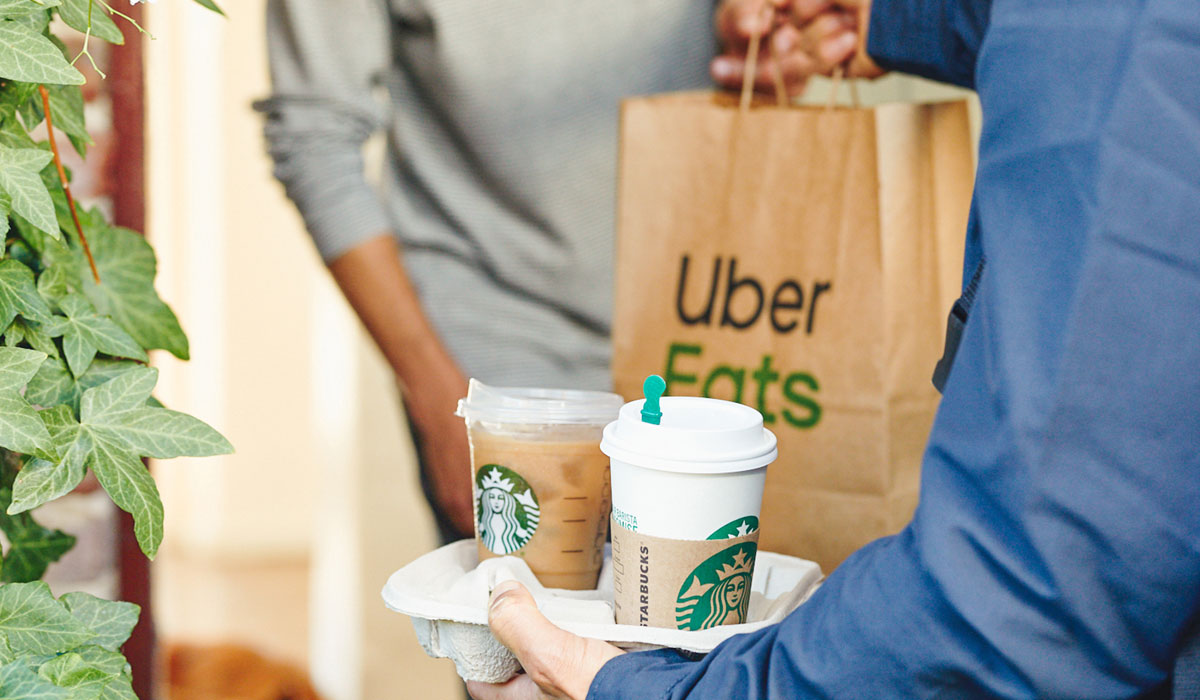Starbucks’ delivery rollout didn’t take long to go national. The company announced July 23 it plans to make the service available “throughout the U.S.” in early 2020 through an agreement with Uber Eats. This comes after an 11-market rollout Starbucks said “demonstrated successful operational integration and received positive customer response to an effortless high-quality experience consistent with the Starbucks brand.”
“We are driven to create new and unique digital experiences that are meaningful, valuable and convenient for our customers,” Roz Brewer, group president and chief operating officer for Starbucks, said in a statement. “Partnering with Uber Eats helps us take another step toward bringing Starbucks to customers wherever they are.”
Starbucks Delivery started last September with a South Florida pilot that covered more than 100 restaurants in the Miami-Dade and Broward counties. By late January, Starbucks expanded to six additional U.S. cities, beginning with San Francisco and then moving to Boston, Chicago, Los Angeles, New York, and Washington, D.C. Starbucks said nearly a quarter of its U.S. company-operated stores, or roughly 2,000 or so, were on board by Q2 of fiscal 2019 (March).
The company did not say Tuesday whether the rollout would include franchise as well as corporate locations, and how many were involved exactly. It only noted that it would spread nationwide. There were 17,710 North America restaurants in April (about 15,000 of those are stateside and 9,496 are company run).
Starbucks said in tests that it “saw strong demand, including repeat business throughout the day and positive feedback from customers.” It reported earlier that delivery orders returned average checks about two-and-half to three times higher than traditional in-store results (low-to-mid teens checks as opposed to the typical $5 order).
The company added Tuesday that, by partnering with Uber Eats, the company can leverage the expertise of the largest global delivery service outside of China “while extending the potential customer base beyond those who currently include Starbucks as part of their morning or afternoon routines.”
In addition to simply offering delivery, Starbucks said the agreement allows the parties to collaborate on innovation and technology integration. They will work together on packaging, in-store operations, and a quick-to-door delivery window.
“Our customers are huge Starbucks fans and love being able to get their favorite items delivered with Uber Eats speed,” Jason Droege, vice president of UberEverything, said in a statement. “We’re excited to expand our partnership across the United States to make ordering their favorite coffee and breakfast sandwich as easy as requesting a ride.”
Delivery will broaden Starbucks’ convenience initiatives. Starbucks Delivers is available via the Uber Eats mobile app. Customers can follow orders within the mobile platform and track progress and location of the courier.
Starbucks said it has developed packaging to help ensure the quality of hot and cold menu items. About 95 percent of core menu items are available for delivery.
Per an earlier article in Miami.com, deliveries were taking less than 30 minutes from the time the order was placed in tests. The option to order Starbucks was showing up on the app only if the store was close enough to meet that goal, J.P. Restrepo, general manager for Uber Eats in Florida, said at the time. In beta testing, Uber Eats said the most popular order was the caramel Frappuccino.
Starbucks’ delivery efforts in China are already rolling. As part of a partnership with Alibaba, Starbucks has worked with Ele.me, China’s leading on-demand food delivery platform with 3 million registered delivery riders, to bring the experience to market.
The company now offers delivery service in 11 of its global markets and expects to test other delivery pilots in other countries this year, it said.
Brewer said previously that via delivery Starbucks unlocked the ability to bring product to customers “for those times when they’re not able to come to us.” In 2018, the U.S. online food delivery market was estimated to be a $17 billion category and is projected to grow to $24 billion by 2023, according to the 2019 eServices Report 2019.
The chain is coming off a second quarter where same-store sales climbed 4 percent in the U.S. versus the prior-year period. Much of the credit went to a retooled menu that drove afternoon transactions and pushed up check. Traffic was flat. Starbucks’ p.m. performance improved for the third consecutive quarter and was its best result in the past three years. Globally, Starbucks’ comps lifted 3 percent, including 3 percent in China.
Starbucks reports third-quarter earnings on July 25.










